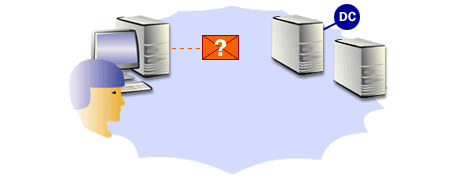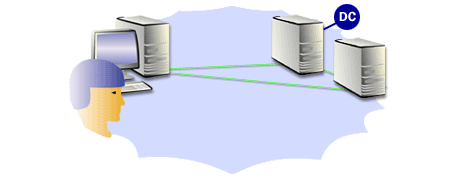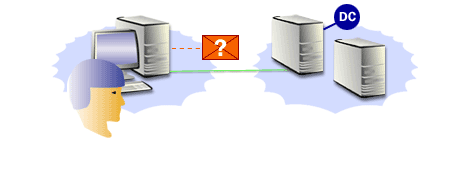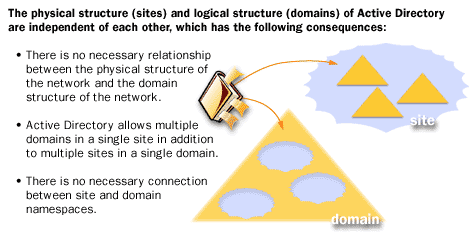| Lesson 3 | Sites |
| Objective | Define Sites and their role in reducing network traffic. |
Reducing Active Directory Network Traffic
Active Directory Sites can reduce network traffic by providing a way to logically group computers and other network resources based on their physical location. By doing so, Active Directory can route authentication and replication traffic within a site, rather than over a wide area network (WAN) connection to a remote site.
This helps to reduce network traffic and improve network performance by minimizing the amount of data that needs to be transmitted over WAN connections. For example, if a user logs in to a computer at a site, Active Directory can authenticate the user locally, rather than transmitting authentication traffic over a WAN connection to a remote site.
Additionally, Active Directory Sites can be configured with replication schedules and bandwidth throttling to further reduce network traffic. Replication schedules allow administrators to control when replication traffic occurs, so that it can be scheduled for off-peak hours when network traffic is lighter. Bandwidth throttling allows administrators to limit the amount of network bandwidth that is used for replication traffic, ensuring that other network traffic is not impacted.
Overall, Active Directory Sites provide a powerful way to optimize network traffic and improve network performance in a distributed environment. By logically grouping resources based on physical location and controlling the flow of traffic between sites, administrators can ensure that network traffic is efficiently managed and network performance is optimized.
This helps to reduce network traffic and improve network performance by minimizing the amount of data that needs to be transmitted over WAN connections. For example, if a user logs in to a computer at a site, Active Directory can authenticate the user locally, rather than transmitting authentication traffic over a WAN connection to a remote site.
Additionally, Active Directory Sites can be configured with replication schedules and bandwidth throttling to further reduce network traffic. Replication schedules allow administrators to control when replication traffic occurs, so that it can be scheduled for off-peak hours when network traffic is lighter. Bandwidth throttling allows administrators to limit the amount of network bandwidth that is used for replication traffic, ensuring that other network traffic is not impacted.
Overall, Active Directory Sites provide a powerful way to optimize network traffic and improve network performance in a distributed environment. By logically grouping resources based on physical location and controlling the flow of traffic between sites, administrators can ensure that network traffic is efficiently managed and network performance is optimized.
Sites Role in reducing Network Traffic
site[1] is a combination of one or more Internet Protocol (IP) subnets connected by a high-speed link. By defining a site, you reduce replication traffic across slower links.
Staying within the same site decreases traffic between domain controllers, which means that the network replication is more efficient.
Note that traffic between domain controllers is a problem with replication.
With logon authentication, the traffic is between client computers and a domain controller. Either situation can cause network congestion when taking place across a slow wide area network (WAN) link.
Workstation logon and replication causes increased Active Directory traffic. To address this, you must ensure that Windows 2000 uses the most efficient links and schedules for replication and logon. Note that sites are used only when a network spans multiple geographic locations that are connected by slow links. Defining sites is of no use on a local area network that is contained at one physical location.
Staying within the same site decreases traffic between domain controllers, which means that the network replication is more efficient.
Note that traffic between domain controllers is a problem with replication.
With logon authentication, the traffic is between client computers and a domain controller. Either situation can cause network congestion when taking place across a slow wide area network (WAN) link.
Workstation logon and replication causes increased Active Directory traffic. To address this, you must ensure that Windows 2000 uses the most efficient links and schedules for replication and logon. Note that sites are used only when a network spans multiple geographic locations that are connected by slow links. Defining sites is of no use on a local area network that is contained at one physical location.
How a logon request is validated
The location of the domain controller impacts how efficiently a logon request is validated. Let us look at an example:


- When a user logs on, Windows will try to find a domain controller in the same site
- Staying within the same sites serves to reduce unnecessary traffic across slow links
- If there is no domain controller in the same site to validate the logon request , Windows will go outside the current site
Benefits of placing Servers into Sites
Defining sites allows you to configure Active Directory access and replication so that Windows 2000 uses the most efficient links and schedules for replication and logon traffic. As an administrator, you create sites for two reasons:
- To optimize replication traffic
- To allow users to connect to a domain controller using a reliable, high-speed connection
Sites (physical structure) and domains (logical structure)
As you know, sites are different from domains, and domains and sites are independent of one another.
The link below reviews the difference between the physical and logical structure of your network:
Sites Domains
The independence of physical and logical structures

- There is no necessary relationship between the physical structure of the network and the domain structure of the network
- Active Directory allows multiple domains in a single site in addition to multiple sites in a single domain
- There is no necessary connection between site and domain namespaces
The physical structure (sites) and logical structure (domains) of Active Directory are independent of each other, which has the following consequences:
- There is no necessary relationship between the physical structure of the network and the domain structure of the network.
- Active Directory allows multiple domains in a single site in addition to multiple sites in a single domain.
- There is no necessary connection between site and domain namespaces.
In summary
In summary, by defining a site, you have better traffic control for both logon and replication, and the network operates more efficiently,
if it has geographically separate locations connected by slow links. In the next lesson, we will discuss domain controllers and how to place a domain controller in a site.
Sites Domains SiteLink
Click the Sites Domains SiteLink below to complete a matching exercise on sites and domains and the role of sites in Active Directory replication.
Sites Domains SiteLink
Sites Domains SiteLink
[1]Site: A site is one or more IP subnets connected by a high-speed link.
Mastering Active Directory